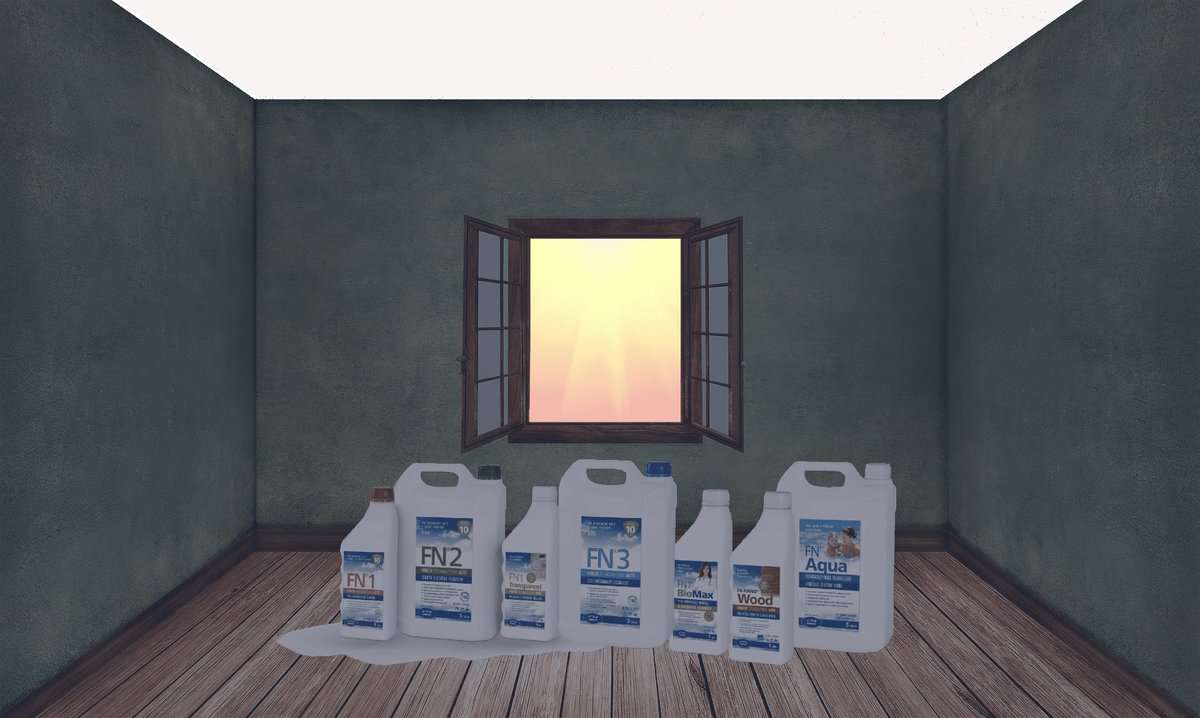Do you want to have beautifully fresh air at home, just like in the mountains? Thanks to advances in nanotechnology, it's no longer a problem. Even in the city, you can enjoy clean air without harmful substances. A special photocatalytic coating with nanoparticles will create an invisible layer on your walls that effectively removes odors, bacteria, viruses, allergens, and exhaust fumes from the interior. It also repels spiders and other insects.
You might be thinking, "What nonsense is this? How can a coating clean the air?" There's no magic or toxic chemistry involved this time. "Good old" physics is the main player.

Nature Has Been Catalyzing Photosynthesis Since the Beginning of Time
Natural daylight leads to the natural and spontaneous decomposition of various substances. However, there's a catch. Under normal conditions, this process takes a relatively long time. Fortunately, today we can significantly accelerate and enhance it with the presence of a photocatalyst in the form of a functional coating with TiO2 nanoparticles.
Where and Why Use FN NANO® Functional Coatings?
Photocatalytic coatings can efficiently purify the air in households, but they have a wide range of other applications as well. They are used in interiors and outdoor areas.
A wall coated with FN NANO will:
1) Clean the surrounding air from odors, pollutants, viruses, bacteria, and other unwanted substances
2) Self-clean its own surface, preserving the material's original appearance, color, and protecting it from UV degradation
You can easily turn your wall surface into a healthy, efficient, and virtually maintenance-free air purifier, which only requires a bit of daily or UVA light to operate.
There are various types of photocatalytic coatings on the market, which differ significantly in terms of effectiveness. If you want real quality, go for FN NANO® coatings, which are approximately 50 times more effective than 1st-generation suspensions. The reason is their much larger functional surface area. After FN NANO® dries, it forms an extremely porous microstructure with photoactive titanium dioxide nanoparticles on the material's surface.
Furthermore, FN NANO® coatings have a significantly longer lifespan. They typically retain their properties for 10 or more years. Additionally, these coatings have a notable Czech connection, as they were created by the world-renowned nanotechnologist Jan Procházka.
In Indoor Spaces
If we stay in indoor spaces, functional coatings are commonly used in food production, restaurants, hotels, and senior care homes. They can effectively deal with "grease dirt" that typically accumulates in restaurants and food service establishments. In these sectors, overall cleanliness and infection control are crucial, so they rely on FN NANO coatings, which effectively eliminate bacteria, mold, and yeast in operations.
FN NANO® suspensions also play a significant role in healthcare facilities, laboratories, and veterinary clinics. The biocidal coating helps maintain a healthy, sterile, and maximally safe environment in these spaces, reducing the risk of infection. The antibacterial properties of the coating have been confirmed by testing at the State Health Institute (SZÚ). Photocatalytic coatings also demonstrably destroy the vapors of disinfectants and other unwanted substances that would typically worsen the comfort of employees and patients in healthcare facilities.
Tip: Use a special foam roller for application, which won't drip, ensuring an easy application process.
In recent years, photocatalytic suspensions have been increasingly used in offices, schools, and kindergartens. There are several reasons for this. In classrooms with a functional nanocoating of TiO2, the illness rate of children during flu seasons has decreased by an average of 30%. Additionally, the coating protects children and staff from hazardous substances that can be released from particleboard furniture and synthetic materials. It reliably destroys toxic substances produced by bacteria in ventilation systems and can also eliminate odors and staleness, ensuring fresh air in offices and conference rooms.
Tip: FN NANO® BioMax: Coating that Destroys COVID-19
In industrial facilities, FN coating significantly reduces operational cleaning costs by effectively preventing dirt buildup. It is also used for air purification from hazardous and foul-smelling substances that standard filtration systems struggle with at lower concentrations. FN NANO® suspensions have proven their worth over the years in plastics production and processing, paint shops, welding, chemical manufacturing, biogas production, and many other industries.

In Outdoor Spaces
For outdoor surfaces , FN NANO® coating is primarily applied for its self-cleaning and protective properties, which can reduce maintenance costs by 20 to 35% annually over the long term.
Main advantages of FN NANO® on outdoor materials:
- prevents the growth of mold, moss, and algae
- actively cleans the surface from soot and other air pollutants
- protects the material from the destructive effects of UV radiation
- significantly extends the lifespan of insulated facades by reducing erosion
- guaranteed functionality by the manufacturer for 10 years
For these reasons, the suspension is used on facades, roofs, and concrete structures. The coating is also suitable for sandstone (granite, limestone, etc.) because it exhibits exceptional moisture permeability. This prevents water accumulation inside the stone and subsequent freezing during winter months, which could lead to irreversible damage.
Photocatalytic coating can also save you a lot of trouble with cultural monuments, outdoor sculptures, and memorials. It can keep historical sites in excellent condition for a very long time, preventing unsightly graying and the growth of algae, moss, and mold. Especially in urban areas, you will appreciate another feature of this groundbreaking nanotechnology. The coating has a special anti-graffiti and anti-sticker effect, making it much more difficult for taggers to paint their graffiti. If graffiti does appear on monuments or facades, it can be easily removed with water and a brush.
It is worth mentioning that FN NANO® coating meets all the requirements for materials used on objects under heritage protection.
Even in outdoor conditions, the photoactive surface of titanium dioxide nanoparticles has the ability to clean the surrounding air of unwanted substances, including noxious exhaust emissions. It is estimated that 100 m2 of facade with photocatalytic coating can purify an incredible 3 million cubic meters of air from emissions from traffic, local heating, and industrial production in just one year.
This means that a building can literally contribute to improving the environment.

Functional Coating Is Most Effective on Ceilings
For maximum effectiveness, it is advisable to use functional coating on the ceilings and walls of your interior. However, this is not a necessity. Air naturally circulates in rooms, and from this perspective, the ceiling is the most effective surface of all possibilities. If it is a room where no smoking occurs, a photoactive coating on the ceiling is sufficient to purify the air.
When deciding to apply FN coating to walls, it is recommended to start from a height of 180 cm and work your way up to the ceiling. Once dry, the functional layer forms an extremely porous microstructure with photoactive titanium dioxide nanoparticles, which is not resistant to abrasion and can chalk easily. While there's nothing stopping you from painting the entire wall down to the floor, this can lead to abrasion and a gradual reduction in functionality.
The good news is that you can easily apply the suspension FN NANO® to the wall yourself. It's not rocket science. Similar to painting with regular paint, you can use a brush, a low-nap roller, or a spray gun. It's ideal to apply three thin layers to the wall. However, each layer must be allowed to dry thoroughly to form the desired microstructure on its surface. Before applying, be sure to shake the suspension thoroughly in its plastic container. Failure to do so will result in nanoparticles only sticking to certain areas, and the coating will not function correctly.

6 Steps to Destroying Microbes
The aforementioned microstructure of FN NANO® transforms 1 m2 of ordinary masonry into 500 m2 of photoactive surface area with TiO2 nanoparticles. Even in a small area, you can have a huge functional surface that cleans the air from impurities.
And how does the nanocoating actually destroy microorganisms? It occurs in 6 basic steps:
1) Capture – The highly porous microstructure essentially functions like a very fine sieve, capturing bacteria, viruses, and microscopic dust particles.
2) Entrapment – Similar to a flytrap, it does not release the captured prey, so microorganisms cannot return to the air.
3) Isolation – The nanoparticles surround the captured microorganisms, isolating them from the environment.
4) Decomposition – Using the energy of light, especially UV radiation, the nanoparticles decompose organic substances, including microorganisms.
5) Inertness – After decomposition, the remains of microorganisms are not hazardous to health and do not release toxins into the environment.
6) Washout – In the final step, rain or simple washing with water removes the decomposed remains from the surface.
Healthy Cleaning Through Photocatalytic Effect
Conventional disinfection introduces various chemicals into the environment, some of which are more or less toxic. In contrast, cleaning through photocatalysis is exceptionally gentle and eco-friendly. Natural sunlight has been breaking down various substances in nature since the beginning of time. Patented coatings with nanotechnologies have simply accelerated and enhanced this entire process.
Functional coatings essentially transform light (UVA radiation) using a photocatalyst (nano-sized titanium dioxide particles) and atmospheric oxygen into an extremely potent cleaning and antibacterial effect.
#produkty#https://www.nanospace.store/search/?string=photocatalytic+coating
When exposed to light, the surface of TiO2 crystal nanoparticles, approximately 100 nanometers in size, generates free electrons and electron holes, which, in combination with atmospheric oxygen, create a strong oxidative reaction. Due to oxidation, the surface of the crystals heats up, and impurities trapped in the microstructure of the dried coating literally burn and decompose down to their basic components.
There's no need to worry, though. The wall maintains its normal temperature throughout the process. No flames will erupt from it. You won't even get burned if you touch a surface coated with FN NANO®. The destruction of impurities occurs at the atomic and subatomic level.
We can illustrate the self-cleaning effect with a situation that everyone has encountered in their life. When you're getting ready to sleep in your bedroom, a mosquito starts buzzing around. After a moment, it lands on the wall, and you triumphantly swat it. Only then do you realize with horror that it leaves that infamous "greasy stain" on the wall. Before you can get back under the covers, your spouse will have explained several times that you'll have to repaint.
If your walls are treated with FN NANO® coating, you can roll over to the other side and say confidently, "No, no need." The stain gradually disappears on its own, and the wall returns to its beautiful white appearance.
In the article, we've already mentioned several times that the coating continuously cleans the air of bacteria, viruses, allergens, odors, and various toxic substances. However, we haven't yet mentioned how long it takes for the functional coating to clean the air of unwanted substances.
It depends on specific conditions. If you have a ceiling with FN NANO® suspension in your kitchen and start frying Alaskan cod or similarly aromatic food, within 20 to 30 minutes, no one will even know that something was cooked.
UVA Light Gives the Coating Endless Lifespan
The manufacturer states that the functional coating will reliably serve you for 10 years or more, but under ideal conditions, the coating's lifespan can be essentially endless. Titanium dioxide (TiO2) nanoparticles only participate as a catalyst in the photocatalytic reaction. This means they remain in the coating and are not consumed.
With sufficient UVA radiation, the surface self-cleans and revitalizes, so the functional layer remains in perfect condition. The microstructure can capture more and more impurities, which gradually break down into completely harmless particles. In the absence of the "right" light, however, the nanolayer will begin to clog gradually, reducing its functionality.
Although the photocatalytic cleaning effect can be activated even with regular daylight, you may need to use special bulbs in homes that serve two functions:
1) Illuminate the space
2) Activate the coating
Modern windows with UV-blocking films eliminate UVB and UVC radiation from daylight, which can be harmful in larger doses, but they also prevent UVA radiation from penetrating, which is safe for humans and can activate the photocatalytic layer.
Therefore, interiors with FN NANO® functional coating install energy-efficient lights with a wavelength of 365 nm for activation. To activate, the nanolayer must be exposed to light with a minimum intensity of 0.2 W / 1 m2. In normal conditions, it's more than enough for the light to be on for a certain part of the day. If you want to take full advantage of the cleaning effect, especially in heavily contaminated areas (smoking rooms, kitchens, etc.), it's worthwhile to have artificial UVA light on 24 hours a day.
Health Safety Verified by Time and Professional Institutions
The entire process of photocatalytic cleaning is 100% healthy, eco-friendly, and safe. Occasionally, someone may worry that nanoparticles will be released and enter the body. However, there's nothing to fear. Titanium dioxide (TiO2) nanoparticles are firmly anchored in an inert mineral structure.
Although some wear and tear on the functional coating may occur, in such cases, relatively large pieces that are much larger than 100 micrometers will break off from the wall.
It's worth mentioning another fact. Even though few people realize it, humanity has been in everyday contact with TiO2 particles for more than 100 years, and so far, no study has shown any harm to human health, animals, or plants. Particles of around 100 nanometers in size are commonly found in yogurts, white bread, and other food products. If you look around you right now, you'll likely see many other products containing titanium dioxide (TiO2) because it's a natural component of titanium white, which is commonly used in office papers, paints, plastics, and other materials.
In more than 100 years, not a single case of negative effects on human health or the environment has been recorded.
In addition, FN NANO® functional coatings are certified and tested by the State Health Institute (SZÚ) and other independent laboratories. The properties and effectiveness of the coatings are supported by numerous studies conducted by the Czech Academy of Sciences, the University of Chemistry and Technology in Prague, the Technical University of Ostrava, and other research organizations in the Czech Republic and abroad.
Summary of the Key Benefits of FN NANO® Functional Coatings
- an excellent addition to air purifiers
- reduces illness rates by actively destroying bacteria, viruses, and other harmful substances
- eliminates odors (cigarette smoke, exhaust fumes, kitchen odors, etc.)
- maintains fresh air and prevents the development of "staleness"
- reduces the accumulation of grease and smoke on walls and furniture
- improves the health of asthmatics and allergy sufferers by removing allergens from the air
- extends the lifespan of materials and underlying coatings
- repels spiders and other insects by disrupting the pheromone trail used for communication
- reliably functions for 10 years or more
Sources
- Anpo, M. (1989). Photocatalysis on small particle catalysis. Reaction intermediates and reaction mechanisms. Research on Chemical Intermediates.
- Inoue, T., Fujishima, A., Konishi, S., Honda, K. (1979). Photoelectrocatalytic reduction of carbon dioxide in aqueous suspensions of semiconductor powder. Nature, 277(5697), 637-638.
- Thampi, K.R., Viswanathan, B., Viswanath, R. (1987). Methanation and photo-methanation of carbon dioxide at room temperature and atmospheric pressure. Nature, 327(6119), 385-386.
- Taniguchi, I. (1979). Electrochemical and photoelectrochemical reduction of carbon dioxide. Helvetica Chimica Acta, 62(7), 2518-2531.
- Halmann, M., Krich, M., Mastai, Y. (1979). Hydrogen generation by visible light irradiation of aqueous solutions of metal complexes—An approach to the photochemical conversion and storage of solar energy. Helvetica Chimica Acta, 62(7), 2440-2447.

